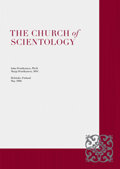The visions of Scientology are to be found in Hubbard’s well‑known texts starting in the 1940s, but particularly since 1950 when his bestselling book on Dianetics appeared.
The relationship of Dianetics and Scientology is both spiritually and historically so close that they might be characterized as two sides of the same coin. At the same time when Dianetics stems from the two Greek words, “dia” (through) and “nous” (soul), Scientology means “knowing about knowing” connecting the Latin word “scio” (to know) to its Greek counterpart “logos.” When on one hand the principles of Dianetics were published as a method offered as a proper “technology of mind,” Scientology, on the other, was emphasized to be a religious philosophy.
Although the English word “science” comes from the very same Greek term “scio,” it might be appropriate to avoid the existing, unnecessary confusion between the two words by making a conscious difference in their pronunciation. One solution might be to pronounce “Scientology” in a Greek, and “science” in an English, manner.
In 1954 the first Church of Scientology was formed with its own creed, formulated by L. Ron Hubbard. The creed clearly shows a society acknowledging itself as a religious body. Included in the creed are the principles that “we of the church believe” in the “equal” and “inalienable rights” of all men as well as the statement that Man is “basically good,” and the four laws of God which “forbid man. …”
Similarities can be found in the teachings of Scientology with such Eastern monistic religions as Hinduism, Buddhism and Taoism particularly. Typically enough, the handbooks on the Scientology ceremonies connect their backgrounds with mythologies of such religious philosophies as Hinduism and Buddhism, and teachings by Aristotle, Spinoza and St. Thomas Aquinas.
Scientology doctrine posits that Man exists and seeks to survive on eight distinct intersecting planes, called “dynamics” in Scientology theology. The specific dynamics run from the self to the family, to groups and on out to the spiritual universe (the seventh dynamic) and the Supreme Being (the eighth dynamic) also called Infinity or God. Each higher dynamic encompasses all of the dynamics below it.
The concept of “God” exists in Scientology teachings but in a different way than in Judaism, Christianity, Islam and the other theistic religions having their roots in the religious traditions of the Near East. In Scientology, God is the highest of the eight dynamics, which the individual strives to embrace and to know fully. In this sense the concept of God, in Scientology teachings, is very personal‑it is really left to the person himself to define it fully.
Scientology doctrine of the spiritual realm is represented in the “thetan,” which is related to concepts in early and new gnosticism; man is supposed to consist of thetan, mind and body. The word “thetan” having its background in a Greek letter “theta” is used in Scientology to avoid the confusion with the previous terms related to “soul.”
The way to spiritual awareness in Scientology is through “auditing,” which is one of the religion’s two central religious practices. Auditing addresses the thetan with ascending levels of religious services that enable the thetan to resolve traumatic experiences in both the present and former lifetimes. This relief brings about higher spiritual awareness.
The way to spiritual awareness in Scientology is through “auditing,” which is one of the religion’s two central religious practices. Auditing addresses the thetan with ascending levels of religious services that enable the thetan to resolve traumatic experiences in both the present and former lifetimes. This relief brings about higher spiritual awareness.
The other central practice of Scientology is called “training” which is the concentrated study of Scientology Scripture‑the writings, recordings and films of Hubbard. Scientology doctrine holds that spiritual salvation can be achieved in this life only through the practice of both auditing and training.





























